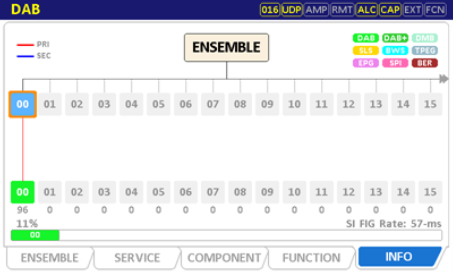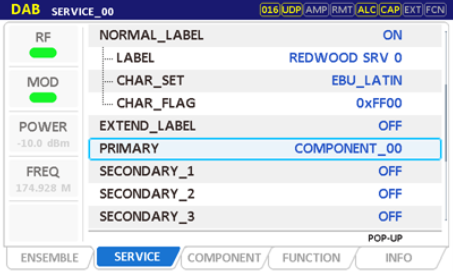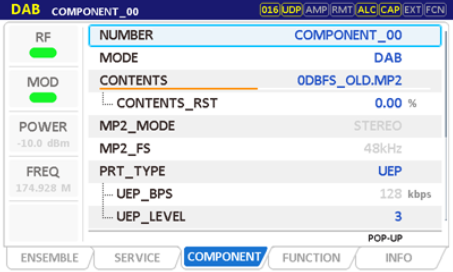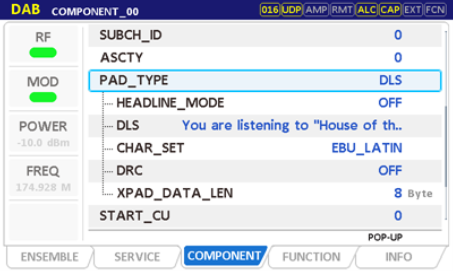1. Introduction
Dynamic Label Service (DLS) and Dynamic Label Plus (DL+) are key applications within the DAB digital audio broadcasting system, providing users with richer and more intuitive display of program-related information.
As DAB technology continues to gain popularity and application, DLS/DL+ functions play an increasingly important role in enhancing user experience and increasing the attractiveness of broadcast services. The completeness of DLS/DL+ functionality directly impacts users' efficiency in accessing broadcast content and their satisfaction. Therefore, exploring the importance of DLS/DL+ functions in current DAB broadcasting and effective testing methods holds significant reference value.
When dealing with DLS/DL+, professional test equipment such as RedwoodComm's RWC2010C signal generator plays an indispensable role.
2. DLS/DL+ Function Overview
DLS Function
The DLS function allows broadcast service providers to embed text information related to programs within the DAB signal. This information typically includes the currently playing song title, artist, program synopsis, etc., displayed on the screen of receiving devices, helping users better understand the program content. DLS messages are contained within the Program Associated Data (PAD) and transmitted via DAB audio frames or DAB+ audio Access Units (AU). By providing short text messages, the DLS function enhances the user experience, enabling users to understand program content more intuitively.
DL+ Function
The DL+ function is an extension of DLS. It creates DL+ objects by storing and filtering parts of the text within DL messages on the receiving device. These objects can be selected and accessed by users independently of the currently transmitted DL messages. DL+ not only inherits the basic characteristics of DLS but also introduces content types and tagging mechanisms, making broadcast content more structured and interactive. DL+ objects can be categorized based on content type, such as program information, news, advertisements, etc. Users can choose to display or filter information of specific types according to their interests.
3. Importance of DLS and DL+ Functions
3.1 Enriching User Perception and Experience
DLS and DL+ functions provide rich text information, enabling users to understand program content more intuitively. For example, users can see the currently playing song title, artist, album information, etc., on their receiving device, allowing for better engagement with the program. Furthermore, the DL+ function supports content type classification, allowing users to choose to display or filter specific types of information based on their interests, further enhancing the user experience.
3.2 Enhancing Broadcast Service Interactivity
DLS and DL+ functions make broadcast services more interactive. For instance, broadcast service providers can use the DL+ function to push real-time news, weather forecasts, traffic information, etc., to users, who can view this information directly on their receiving devices. Additionally, the DL+ function supports user interaction with broadcast content, such as voting or commenting, enhancing the interactivity between users and the broadcast service.
3.3 Compliance with Relevant Standards Requirements
To meet export requirements for European and Middle Eastern regions, in-vehicle infotainment (IVI) systems must comply with the following standards, both of which specify requirements for DLS/DL+:
ETSI TS 102 980 Standard
The ETSI TS 102 980 standard defines the DLS and DL+ functions in detail, including their content types and tagging mechanisms. The standard states that the DLS function allows embedding program-related text information in the DAB signal, typically including the currently playing song title, artist, program synopsis, etc. The DL+ function is an extension of DLS, allowing the storage and filtering of parts of the text (sent as DL messages) on the receiving device to create DL+ objects. These objects can be categorized based on content type, such as program information, news, advertisements, etc., and users can choose to display or filter information of specific types according to their interests. Specifically, the standard mentions:
"Dynamic Label (DL): feature of DAB for providing a programme with text messages; it also provides commands, for example, for presentation on the receiver terminal."
"Dynamic Label Plus (DL Plus): extension of the Dynamic label feature; it allows storing and filtering parts of the text (sent as DL messages) in the receiver terminal as DL Plus objects, which then can be selected and accessed by the listener independently from the currently transmitted DL messages."
Furthermore, the standard specifies the creation and classification mechanisms for DLS and DL+ objects, ensuring users can choose to display or filter specific types of information based on their interests. This not only improves the user experience but also enhances the interactivity and competitiveness of broadcast services.
UAE.S 5021:2018 Standard
UAE.S 5021:2018 is a terrestrial wireless broadcasting technical specification issued by the Emirates Authority for Standardization and Metrology (ESMA), aimed at promoting the adoption and application of the Digital Audio Broadcasting (DAB+) system. This standard mandates that, starting from 2020, all vehicles exported to the UAE market must gradually be equipped with DAB+ digital radios, with the installation ratio increasing annually until reaching 100% compliance by 2023. The specification covers all types of receivers, including home appliances, portable receivers, and vehicle receivers. All car radio receivers should be capable of receiving terrestrial AM, FM, and T-DAB+ sound broadcasting services and must comply with the technical requirements mentioned in Annexes (1) and (2). For T-DAB+, receivers must be capable of playing back "sufficient audio reception" and must pass objective audio tests and performance audio tests. The standard also emphasizes requirements for data channels (DATA CHANNEL: SLS/EPG/SPI/DLS), ensuring DAB+ devices can stably and accurately transmit and receive digital audio broadcast signals, providing users with high-quality digital audio programs and data services.
4. DLS and DL+ Function Test Methods
Professional test equipment such as RedwoodComm's RWC2010C signal generator can perform specialized DLS/DL+ testing. The RWC2010C can simulate the broadcast signal transmitter, generating test signals containing DLS and DL+ data. Testers can precisely control the content, format, update frequency, etc., of the DLS and DL+ data by configuring parameters on the RWC2010C, ensuring the generated data complies with relevant standards and specifications.
You can use the RWC2010C's DAB multiplexer for real-time editing and transmission, or use the provided ETI streams for transmission.
1. DAB Multiplexer:
① Signal Source Settings:
(1) ENSEMBLE: Set Frequency/Channel as per test requirements. Initial power can be set to -20dBm. Defaults for others (Enable SERVICE 00);

(2) SERVICE 00 Settings: PRIMARY: COMPONENT 00; Defaults for others;
(3) COMPONENT 00 Settings: MODE select DAB, any mp2 file.


PAD TYPE select DLS/DL+.
DLS Editable. Defaults for others.
② Receiver Settings:
(1) Check if DL+/DLS function is enabled;

2. ETI Stream Playback:
① Signal Source Settings:
(1) Select the ETI/MDI playback module in the menu, and set the required power and frequency;
(2) CONTENTS select a stream carrying DL+/DLS;
② Receiver Settings:
(1) Check if DL+/DLS function is enabled.
5. Conclusion and Introduction to Core Test Instrument
DLS/DL+ data services are one of the important applications of the DAB broadcasting system, enhancing the user experience and increasing the attractiveness of broadcast content. In the research, development, and application process of DLS/DL+ data services, professional test equipment such as RedwoodComm's RWC2010C signal generator can comprehensively evaluate the performance and stability of DLS/DL+ data services, providing strong support for the optimization and improvement of in-vehicle receiver products.
- Supports DAB, DAB+, DMB, DRM30, DRM+, AM, FM, and RDS systems;
- Supports multiplexer for autonomous broadcast content editing, with fully controllable parameter settings for broadcast generation;
- Supports various data services including BWS, TPEG, EWS, EPG, SLS;
- Supports ETI and MDI file player functionality, with free provision of various test streams;
- Supports AM/FM radio test functions and fully editable RDS test functions;
- Modular design, allowing users to select instrument configuration as needed;
- Features optional power amplifier RWC9500B to meet maximum input power test requirements.
If you are interested in DLS/DL+ related testing, please feel free to contact our company. Tel: +86-10-64327909.